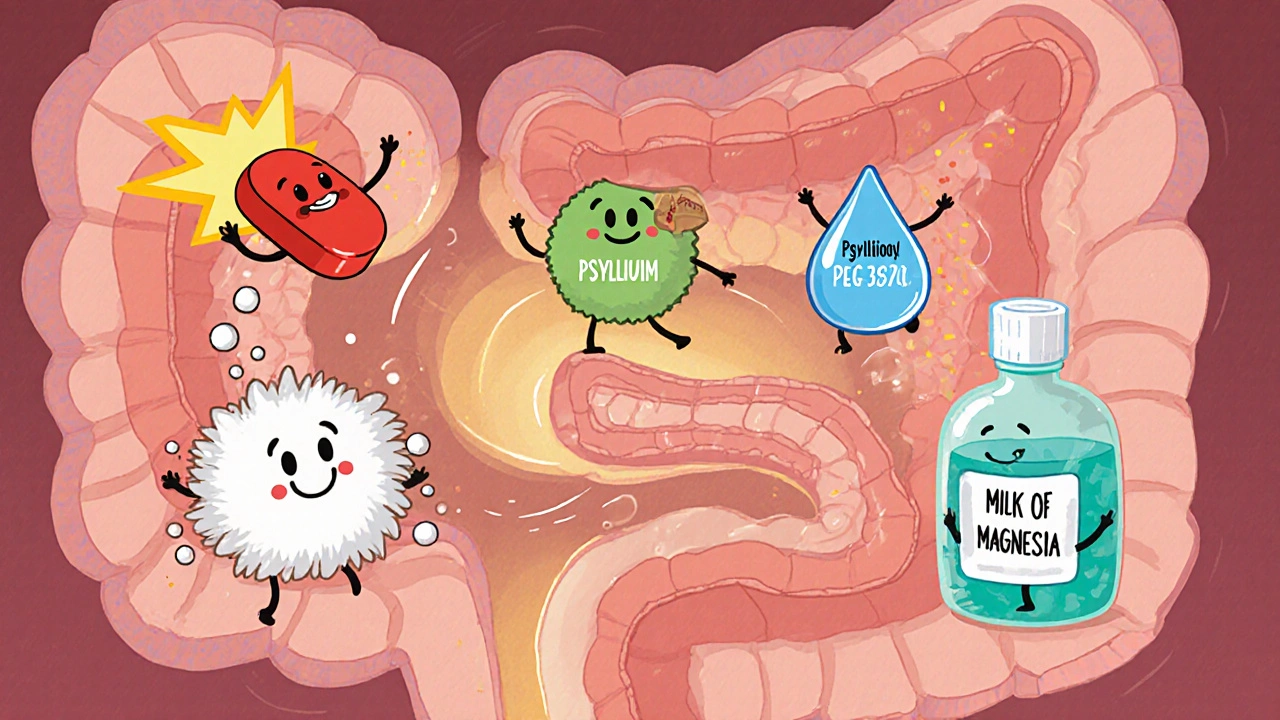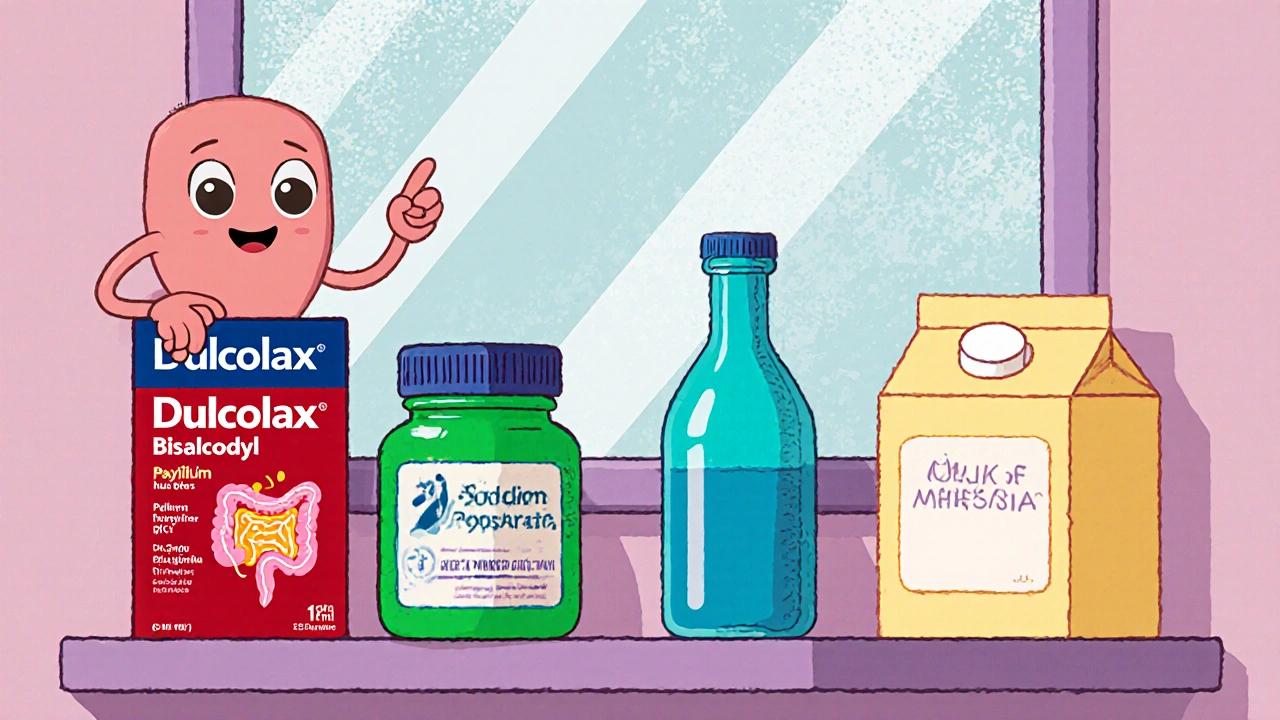When it comes to tackling occasional constipation, many people reach for Dulcolax (Bisacodyl), a stimulant laxative that’s been on pharmacy shelves for decades. But is it always the best choice? Below we break down how Dulcolax stacks up against the most common over‑the‑counter options, so you can decide which one fits your lifestyle and health needs.
Key Takeaways
- Dulcolax works by stimulating intestinal muscle contractions; it acts fast (6‑12hours) but can cause cramping.
- Bulk‑forming agents like Psyllium husk take longer (24‑72hours) but are gentler and improve regularity.
- Osmotic laxatives such as PEG 3350 (MiraLAX) offer a balance of efficacy and mild side effects.
- Electrolyte‑based products (Sodium Phosphate) work quickly but aren’t recommended for people with kidney problems.
- Choosing the right product depends on speed of relief, tolerance, underlying conditions, and personal preference.
How These Laxatives Work
Stimulant laxatives - like Dulcolax - trigger nerve endings in the colon, prompting stronger muscle contractions that push stool forward. This rapid action is great for occasional blockage but can lead to abdominal cramps.
Senna works similarly to Bisacodyl, activating the same receptors; however, its active compounds (sennosides) may cause a harsher stool.
Osmotic agents - PEG 3350 (MiraLAX), Milk of Magnesia (magnesium hydroxide), and Lactulose - draw water into the gut, softening stool and making passage easier. They generally have a smoother onset and fewer cramps.
Bulk‑forming agents such as Psyllium husk increase stool volume, which naturally stimulates peristalsis. The effect is milder but requires consistent daily use.
Speed of Relief
| Product | Typical Onset | Formulation |
|---|---|---|
| Dulcolax | 6‑12hours (oral), 15‑60minutes (suppository) | Tablet, suppository |
| Senna | 6‑12hours | Tablet, tea |
| PEG 3350 (MiraLAX) | 24‑48hours | Powder |
| Milk of Magnesia | 30‑60minutes (liquid), 6‑12hours (tablet) | Liquid, chewable tablet |
| Psyllium husk | 24‑72hours | Powder, capsule |
| Lactulose | 24‑48hours | Syrup |
| Sodium Phosphate | 15‑60minutes (oral) | Liquid, tablets |
Typical Dosage and Forms
- Dulcolax (Bisacodyl): 5mg tablet once daily or 10mg suppository as needed.
- Senna: 15‑30mg of sennosides (often 2‑4 tablets) once daily.
- PEG 3350 (MiraLAX): 17g (about 1heaped tablespoon) dissolved in water once daily.
- Milk of Magnesia: 30‑60mL liquid or 1‑2 tablets (400‑800mg) daily.
- Psyllium husk: 5‑10g (1‑2 teaspoons) mixed with liquid, up to 3 times a day.
- Lactulose: 15‑30mL syrup (10‑20g) daily.
- Sodium Phosphate: 1-2tablespoons (15‑30mL) oral solution as a single dose.

Side‑Effect Profile
Understanding potential adverse effects helps you avoid uncomfortable outcomes.
| Product | Typical Side Effects | Serious Risks (if any) |
|---|---|---|
| Dulcolax | Cramping, urgency, mild diarrhea | Electrolyte imbalance with prolonged use |
| Senna | Abdominal pain, brown‑black stool | Potential melanosis coli with chronic use |
| PEG 3350 | Bloating, flatulence | Rare electrolyte disturbance |
| Milk of Magnesia | Loose stools, magnesium taste | Hypermagnesemia in renal impairment |
| Psyllium husk | Gas, mild bloating | Risk of choking if not taken with enough fluid |
| Lactulose | Flatulence, abdominal cramping | Rare metabolic acidosis |
| Sodium Phosphate | Rapid diarrhea, nausea | Kidney injury, electrolyte shifts |
Who Should Use Which Laxative?
Not every product is suitable for every person. Here’s a quick guide:
- Fast‑acting need (e.g., travel, post‑operative): Dulcolax or Sodium Phosphate.
- Gentle daily maintenance: Psyllium husk or PEG 3350.
- Pregnant or breastfeeding: Milk of Magnesia (under doctor’s advice) or low‑dose Psyllium.
- Kidney disease or on diuretics: Avoid Sodium Phosphate and high‑dose Milk of Magnesia; PEG 3350 is usually safe.
- Older adults prone to dehydration: Choose bulk‑forming agents with plenty of fluids.
Decision‑Making Checklist
- Determine how quickly you need relief.
- Check any medical conditions (kidney, heart, pregnancy).
- Assess tolerance for possible cramping or gas.
- Consider whether you want a once‑off dose or a product you can use regularly.
- Review cost and availability (most are OTC, but some require prescription in the UK).
Practical Tips for Safe Use
- Always read the label for maximum daily limits.
- Start with the lowest effective dose; increase only if needed.
- Drink at least 8oz of water with fiber‑based products to prevent blockage.
- Avoid using stimulant laxatives (Dulcolax, Senna) for more than two weeks without medical supervision.
- If you experience severe abdominal pain, blood in stool, or vomiting, stop the product and seek medical advice.
Bottom Line: Which One Wins?
If you need quick relief and can tolerate a bit of cramping, Dulcolax remains a solid choice-especially the suppository for the fastest effect. For everyday constipation prevention, an osmotic laxative like PEG 3350 or a bulk‑forming fiber such as Psyllium husk provides a kinder, more sustainable approach. People with kidney problems or those on multiple medications should steer clear of Sodium Phosphate and high‑dose Magnesium preparations.
Frequently Asked Questions
Can I use Dulcolax every day?
Occasional use is fine, but daily use can cause dependence and electrolyte imbalance. Talk to a doctor if you need regular help.
Is Psyllium safe for children?
Yes, in age‑appropriate doses (about 1tsp mixed with water). Always ensure they drink enough fluid to avoid choking.
What’s the difference between PEG 3350 and Milk of Magnesia?
PEG 3350 is an inert polymer that pulls water into the colon without adding electrolytes, while Milk of Magnesia provides magnesium ions that can affect electrolyte balance, especially in those with kidney issues.
Can I combine Dulcolax with a fiber supplement?
Occasionally, but don’t make it a habit. Using both can cause excessive bowel activity and cramps.
Are there any natural foods that work like Dulcolax?
Prunes and figs contain sorbitol, a mild stimulant similar to Bisacodyl, but they act slower and are gentler.

Sarah Pearce
October 16, 2025 AT 16:58Well, this article is… super detailed??!! I guess it covers everything, but reading through all the tables is kinda a snoozefest… definatly more than I needed!!
Ajay Kumar
October 20, 2025 AT 04:18Thanks for breaking it down, Sarah! I think the overview really helps people figure out which laxative fits their lifestyle without getting overwhelmed.
Roger Cole
October 23, 2025 AT 15:38Bulk fibers are best for long‑term regularity.
Krishna Garimella
October 27, 2025 AT 02:58When you look at the spectrum of over‑the‑counter laxatives, the choice is really a balance between immediacy and gentleness. Quick‑acting agents like Dulcolax provide relief in under half a day, which is great for occasional blockage but comes with the trade‑off of cramping. On the other hand, bulk‑forming fibers such as psyllium teach your gut to move on its own through increased stool volume. That slow, steady approach can also improve the microbiome over time, something you simply don’t get from a stimulant. Osmotic options like PEG 3350 sit somewhere in the middle, pulling water in without harsh stimulation. They tend to cause bloating, yet most users find the side‑effects tolerable compared to the sudden urgency of stimulant pills. Kidney patients must steer clear of sodium phosphate, because the electrolyte surge can stress already compromised filtration. Pregnant individuals often prefer magnesium‑based solutions, but even those require doctor oversight to avoid hypermagnesemia. If you’re traveling and need a rapid fix, a suppository of bisacodyl can work in 15 minutes, but remember it’s not a daily habit. The body can develop dependence on stimulants if you reach for them week after week, weakening natural peristalsis. A practical tip is to start low-maybe half the recommended dose-and watch how your colon reacts. Hydration is non‑negotiable; without enough water, fiber can become a choking hazard rather than a helper. Cost‑wise, most of these products are cheap, yet insurance may cover certain formulations for chronic conditions. Psychologically, some people feel better taking a pill that acts fast, while others enjoy the routine of a daily fiber shake. In the end, the best laxative is the one that aligns with your medical profile, schedule, and tolerance for side‑effects. So experiment responsibly, keep a diary if needed, and consult a professional if you find yourself relying on the fast‑acting options more than once a month.
nalina Rajkumar
October 30, 2025 AT 14:18Totally agree 🙌 slow‑and‑steady wins the race 😊
elvin casimir
November 3, 2025 AT 01:38The piece completely ignores that many Amerricans rely on over‑the‑counter options because our healthcare system forces us into self‑medication; it’s a sad reminder of how broken our drug‑approval process really is, and the author should have highlighted that glaring issue.
Steve Batancs
November 6, 2025 AT 12:58While it is true that self‑medication is prevalent, the article objectively presents the pharmacological profiles without political bias, adhering to clinical evidence rather than nationalistic commentary.
Ragha Vema
November 10, 2025 AT 00:18Did you ever notice that the big pharma giants secretly push stimulant laxatives in the night‑time ads so we stay hooked? It's like they're engineering dependence while pretending to help us!
Scott Mcquain
November 13, 2025 AT 11:38Indeed, exploiting vulnerable individuals for profit is a reprehensible act, and we must condemn such manipulative tactics that prioritize corporate gain over genuine health.
kuldeep singh sandhu
November 16, 2025 AT 22:58Honestly, I think the panic is overblown; most people use these products responsibly and the supposed “conspiracy” is just good marketing, not a sinister plot.
Mariah Dietzler
November 20, 2025 AT 10:18Honestly, seems like a lot of fluff for a simple issue.